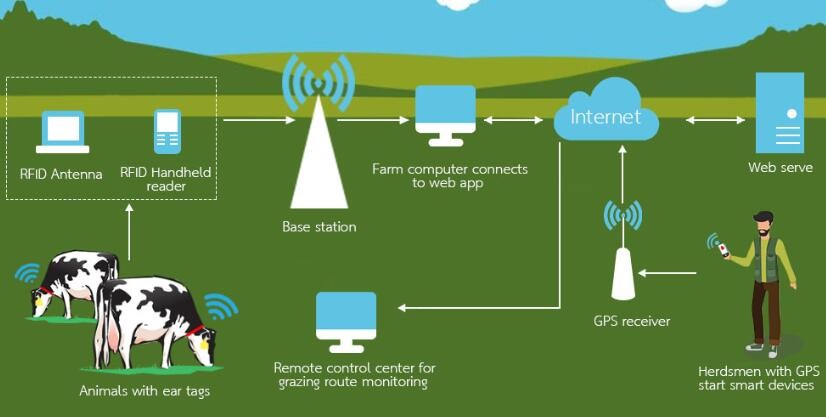RFID Animal / Livestock Identification Solution
- Home
- Pages

RFID Solution Of Animal Identification:
Injectable RFID tags are now available.They are injected to remain under the skin of the animal while delivered through a special syringe, their advantage is that they are less painful also there is no outside identification mark for a malicious person to know where the tag is embedded in order to remove it or modify it.The RFID chip inside the tag is generally ‘Read-Only” so that data once recorded cannot be modified.
RFID Solution Of Animal Identification:
The concept of animal tagging is nothing new. In early days, the various cattle farms and ranches used methods like branding irons, to label the name or symbol of the ranch to which an animal belonged.A red hot branding iron, having the proprietary mark of the farmer or rancher, was used on the poor animal to etch out a mark on its hide.(This is the origin of the term “brand” for an item. Surprising, isn’t it?)
Thus if the animals grazed in a common area, the cowboys or shepherds could identify their animals because of the branding. There were obvious disadvantages to this system, one of them being that it was a painful process for the animal itself. After branding, the actual identification of the animals was done manually. The only advantage was, that there was little room for dispute with another animal owner or ranch owner about the rightful ownership of a particular animal.Present Situation
Branding gave way to physical plastic tags mounted on the animals in holes made in their ears specifically for this purpose, Though! identification was still done manually.This was the situation for cattle and other commercially raised animals and there was no system however for pets too.Therefore pet owners always had problems when it came to identifying lost pets.
Usually they had to rely on some birth mark or the animal’s response to a name when called out, or the animals affectionate reaction to the owner—a very subjective way of identification indeed.With the advent of RFID technology, the plastic dumb tags began to be replaced with RFID tags. They were still mounted in the same fashion, but now there were several more advantages. The first was that the tags were read easily from a distance, with a hand held reader. The tags themselves were just a number, but this number pointed to a large amount of data in a remote database which contained other information about the animal like age, vaccination and medication record.This made record keeping easy and efficient without becoming a pain for the ranch owner. It also satisfied emerging requirements about traceability and food safety, especially after the mad cow disease and similar scares.
Advantages Over The Earlier System:
- Was not painful to the animal.
- Visible only to an RFID reader
- Unique number for every tag and every animal, so no duplication, error of confusion.
- Easily maintain electronic records of vaccination and medication, health checkups.
- Provides audit trail traceability for food safety in case of cattle.
- In case of pets, provides a fool proof identification system in case the pet is lost or stolen.
Likely Future Scenarios:
- The government or other statutory authorities may mandate that all animals should be tagged whether pets,cattle,livestock or endangered wild species.
- Pet tagging would have the records of pet health easily available including vaccinations for, say! The rabies vaccine which is normally given to pet dogs.Livestock tagging would enable government monitoring of the food chain.
- International trade bodies and industry associations may mandate that all food produced from farm animals require traceability to the particular animal from which the food was made, So the records of the animal can then provide clues.This will be useful in case of future outbreaks of hitherto unknown diseases.
- Endangered species tagging can enable environmental agencies to monitor the numbers of particular animal races. Radio tagging is present being used, but not on a large scale.Many places still use crude methods like looking for the animals droppings, spotting them from the air and etc.Due to this only estimates of numbers are available, never the actual numbers.Also there is now way to have a census or to know if poachers have killed any of the animals.
- RFID Fixed Asset Management
- RFID Anti-Theft Systems
- RFID Jewellery Tracking System
- RFID Untouched Attendance
- RFID Warehouse Management
- RFID Animal Identification
- RFID Vehicle Identification
- RFID ETC(Electronic Toll Collection) Solution
- RFID Laundry Management
- RFID Student/Parent Auto Voice Calling at School
- RFID Royalty Customers Deals at Shopping Malls
- RFID Document Management
- RFID Anesthetic Dosages
- RFID Baggage Handling
- RFID People & Personnel Tracking
- RFID Blood Banks
- RFID Car manufacturing
- RFID Drug Pedigree
- RFID Event Management
- RFID Race Solution Sports Events
- RFID Food Safety
- RFID National Identification
- RFID Gasoline Dispensing
- RFID Hotels & Resorts
- RFID Work in Progress Tracking
- RFID Hospital Stores Management
- RFID Medical Surgeries
- RFID Based Patient Location Confirmation
- RFID Body Temperature Monitoring System
- RFID Body Temperature Monitoring for Employees
- RFID Mother Baby Pairing
- RFID Museums
- RFID Spool Tracking System
- RFID Plane Spare Parts
- RFID Industry 4.0 Smart Manufacturing
- RFID Container Tracking System
- RFID Intelligent RFID Parking System
- RFID Office Printers & Cartridges
- RFID Real Time Location Tracking (RTLS)
- RFID Retailing
- RFID Underground Sewers
- RFID Forklift Automation
- RFID Sales Staff Tracking at Shopping Malls
- RFID Trial Room Analytics at Shopping Malls
- RFID Traffic Management
- RFID Guard Patrolling System
- RFID Weightbridge Automation System
- RFID E-Lock for Contrainers
- RFID E-Seal for Contrainers
- RFID Waste Management
- RFID Yard Management

Can we help you?

